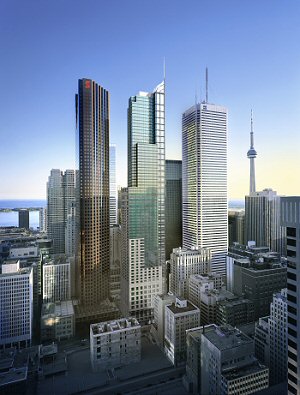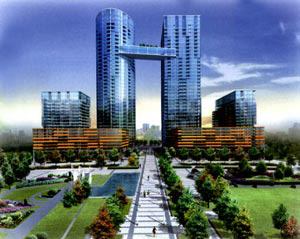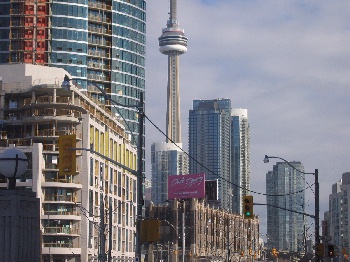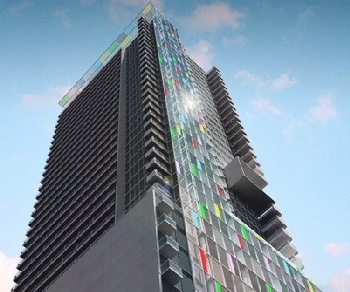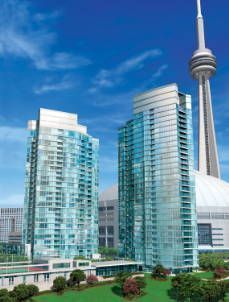|
|
|||||||||||||||||||||||||||||||
|
Toronto's Condos & Highrises
Toronto is growing sky high The only thing missing from this space-age city is ... space. From Scarborough in the east to Etobicoke in the west, between the upper fringes of North York and Lake Ontario to the south, the city is officially tapped out. "All land has something on it," says Eric Pedersen, a program manager at Toronto's urban planning department. "We don't have any `green field' left." The new mission? To boldly grow where we've already gone before. "What we're talking about now is intensification." In cities around the world, the terms may change — smart cities, New Urbanism, compact cities — but the idea is the same: turn strip malls, parking lots and one- or two-storey buildings into places where ever more people can live, work and play. Build upward, instead of outward. Cue the condominium. "Basically all that we're doing is building condos right now," Pedersen says. "That's what the market is saturated with." And, at least on paper, that's a good thing. Up with the subway; down with cars and the city-choking pollution they bring. People can live and work and play in the same civic sphere. Better to live in Manhattan, one might say, than Markham. We're certainly buying that, as highrise condos, even those with expressway vistas, are being bought up in record numbers. According to the Greater Toronto Home Builders' Association, 2,397 highrise condos were sold this past June alone — about 44 per cent better than in that month the previous year, and an all-time sales high. It works out to one new highrise unit sold every four minutes in Toronto. Blame it on the young. The baby-boom echo generation is flooding the city looking for cheap accommodation.
"When you're young you can only afford small spaces," says David Foot, author of the bible on demographics, Boom, Bust & Echo. "And you enjoy noise and action. That's what urban intensification gives you." As you age, you might like the city a little less, well, intense. Thirty- and 40-year-olds, Foot notes, tend to gravitate toward semi-dense environments in the suburbs that they feel are best for raising kids. "People in their 50s and 60s want more peace and quiet," he continues. "And they want less density in general." But many of them will still buy into the highrise scene, he adds, because they want to enjoy the entertainment the city offers. Expect to find them living, however, in larger spaces and on higher floors where the noisy grind of street life is a little more subdued. Also, expect them to be complaining about the noise the most. But in the end, Foot observes, we all head to the same close quarters. "You get to your 70s and 80s and you're more likely to need care — and care then involves coming back to more dense environments and ultimately the nursing home." Think of it as the circle of urban life. But a compact city reveals itself in more than age. It also tends to be more diverse, if not economically, at least ethnically. "Immigrants both tend to be young and they tend to be starting in their careers," Foot says. "So immigrants tend to go into those environments too. For certain immigrant communities, the community is very, very important to maintaining their identity. Some ethnicities are more willing to trade privacy and space for community." Somewhere in the crunch, some people may be trading even more — their ties to the city at large. "A lot of the condos today are really vertical gated communities," says urban planner and York University professor Gerda Wekerle.
They come complete with a gatekeeper (a.k.a. concierge), swimming pool, gym, movie theatre and whatever your monthly condo fees can buy. "We don't really know if these folks are getting widely involved," Wekerle adds. "We're assuming that they really want to be in the city and use everything there is in the city, but there's not much data because all of this has been happening so quickly." In the background there's a steady, persistent refrain from developers and urban planners: density is good. "It's over and over and over again," Wekerle says. "It's a concerted attempt to reshape the way we think about what's happening in the city." Wekerle has spent much of her career studying high-density issues, namely the mile-high monument to intensification known as the residential highrise, whether it's condos or apartments. And it's led her to challenge the idea that if you plunk a condo down somewhere in the city, you can call it a neighbourhood. "These folks who move into a 30-storey building, do they get involved in the neighbourhood? Do they care what the parks are like and the street? "If a lot more people end up in places where the services are privatized and they pay for them ... are they really going to care about public services? Are they going to make an effort? Are they going to become part of the wider community?"
|
|
||||||||||||||||||||||||||||||
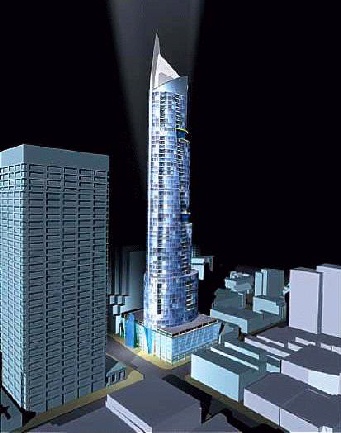
Leslie Kern, a York PhD student writing a dissertation on first-time condo buyers, shares those concerns. "There are certain neighbourhoods that are just condos, like the Harbourfront," she says. "There's no reason to go there unless you live there. It's just kind of taking up space, but not necessarily integrating itself into the community ... "They're increasingly privatized spaces," she adds. "People are, in many ways, encapsulated in their own buildings. "In a way, it's kind of allowing the city to back off a little bit from its responsibilities for providing public spaces." The jury is still out on whether all these freshly minted developments will transform into bona fide neighbourhoods. But some developers, at least, are beginning to look beyond their own walls. When completed, CityPlace will parachute some 18,000 new residents into its 20 highrises, half-dozen low-rises and 100 townhouses along Lake Shore Blvd., from Bathurst to the Rogers Centre. So far, it's unoccupied, with only the eastern side almost complete. But the development would seem the ultimate model, for better or worse, of intensity. "They have done a number of things to try and reach out to the outside community as well as those that are living within," says Vickie Griffiths of Vicbar Marketing, who has been or is currently a consultant for a wide range of developments, from CityPlace to Malibu to Liberty Village. CityPlace will include an eight-acre park, accessible to the public, as well as a daycare facility that's open to residents and non-residents. But not everyone is enthusiastic about the incoming residential juggernaut.
In July, digging at CityPlace ground to a temporary halt after someone poured dirt into gas tanks and air filters of the earthmoving equipment. About $2 million in damages later, an anonymous emailer from the "Earth Liberation Front" claimed responsibility for the act of urban sabotage. It may have been an isolated and extreme act, but protests prompted by other highrise developments throughout the city indicate that some citizens emphatically are not on the compact-city bandwagon. The question lingers: can this brand of intensification actually fill not only physical space, but also social space on the urban landscape? Ultimately, Toronto isn't going to get all worked up overnight. Intensification has historically been a series of fits and jerks. A boom in the 1960s and early '70s, for instance, saw the rise of St. Jamestown, Flemingdon Park and Yonge and Davisville. Highrises don't exactly evolve into their current state. St. Jamestown practically fell from the sky in 1968, blasting away scores of single-family dwellings and getting intense all at once. Indeed, the mini-metropolis towering south of Bloor, between Sherbourne and Parliament, remains Canada's densest area. Some 35,000 souls share the same square kilometre. All the rush to grow upward startled more than a few people. In 1972, mayor David Crombie enacted a 45-foot height limit. "The worry was that downtown was going to be completely torn down for tall buildings," says Pedersen of the city's urban planning department. "We're past that now. The neighbourhoods that are low-scale are protected. We're not tearing down neighbourhoods. Our intensification tends to be happening on vacant parking lots or very under-utilized sites, which have very low-scale buildings in areas that could be much higher." Indeed, Pedersen says about three-quarters of the city doesn't qualify for intensification, being either stable residential low-rises (houses), parks or cemeteries. He notes that the main candidates for intensification are the downtown core, the centres of North York, Scarborough and Etobicoke, and along major arteries, especially northern stretches of Yonge and Bathurst, as well as parts of Bayview, McCowan and Wilson, collectively called the avenues. Katie Williams, a professor and author at the Oxford Centre for Sustainable Development in England, says intensification packs in a lot of benefits with all those people. There's land conservation, "because you're getting a lot of people on a small plot of land." And there are financial benefits through increasing the local economic capacity of the area. "What happens when you intensify an area is you keep the money circulating in the local economy for longer," Williams says. There's some question about the social benefits. "You could argue that it's meeting some sort of housing need, although if private condos are that expensive, they're probably not meeting a social housing need or an affordable housing need. "But I doubt if they're contributing to improving social inclusion or anything like that."
So an intense city is youthful, diverse and maybe a little cramped, with perhaps some pockets disconnected from the rest of the metropolis. One social benefit may be safety. "In denser areas, where there is a greater street life, we generally think of those as having greater safety," says Connie Guberman, a professor at the University of Toronto specializing in urban planning and design for personal safety, "because there's more people doing things." Safety begins at the planning phase, not just for highrises but for any neighbourhood. Lighting, Guberman says, is vital. Then there's signage — do you know where you are and how to get to where you want to go? Because you don't want to be feeling, or even appearing, disoriented. In the past, Guberman has worked with New York City transit, helping create safe environments in the system. She considered not only the movement of people, but also the message the city wanted to convey to the public — "Is this is a caring community? Do we know where to report something if we witness something that makes us feel uncomfortable or if something happened to us?" What about managers at subway stations, "so there's "someone with an official presence to show that the institution or the subway or the train station cares, and if something is happening, there's someone to go to. "The most important measure is to show that we are a community — that in every pocket or neighbourhood or park or streetscape, there are people who connect with each other. There's someone somewhere you can go to if you have a problem. And that gives a message to folks who want to do bad things, that they're going to be seen doing it." One thing that's certain here in Toronto: everything we know about the shape of our city is likely to change. Cities are always in flux, ever evolving toward new models as they grow. Williams calls the next urban phase polycentrism. A city of 10 million, for instance, would have more than one big centre, with city planners increasing density around each urban capital. "That's more efficient and realistic for travel purposes and for making for small neighbourhoods," Williams says.
The city's official plan, a 110-page publication released in 2002, is already preaching the gospel of polycentrism, dividing Toronto into urban centres — Downtown, Etobicoke, North York, Scarborough and Yonge-Eglinton. North York Centre, the plan notes, is focused on three subway stations on its Yonge St. spine. Thanks to ready connections with downtown, the centre boasts a major concentration of office space. Those offices, the plan notes, are expected to grow alongside a "vibrant residential and cultural centre." But, as University of Toronto professor and transportation engineering expert Eric Miller hastens to warn, sometimes the problem isn't so much what changes when a city compacts, but what doesn't change. "I think it's easy to get lost in the rhetoric," he says. "The concept is fine, but are you doing the full package of transit, walkability and mixed use to go with the density that makes it all work? "If they are just mega-apartment buildings, from a transportation perspective, they're just going to generate flows out in the morning and flows in the evening and may not contribute much to balanced transportation. Indeed, Miller says that without bulking up on transit, the effects of all that density could be exactly what we are supposed to be guarding against — actually increasing car traffic in particularly developed areas. "Much of what's been going on in Toronto for a long time, it's kind of living off the existing capacity that was put in place quite a while ago." Fortunately, compared to other major cities, Toronto is still in the earliest phases of intensity, with plenty of room to chart its trajectory. At present, there are just 2,650 people per square kilometre. By contrast, witness Kabul, Afghanistan, with about 14,350 people per square kilometre. In Dhaka, the capital of Bangladesh, it gets a little more extreme, with 32,550 people staking out each square kilometre. Hong Kong takes top prize with 44,511 people occupying a single square kilometre. But ultimately, as the pot thickens in Toronto, will it be a city we can recognize, or even make a connection with? The most important measure is to show that we are a community, says Guberman, that in every pocket or neighbourhood or park or streetscape, there are people who connect with each other. For highrise dwellers, be it condos or apartment complexes, the message may be simple: come down from the tower. Guberman recalls a striking example of how a handful of downtown highrise dwellers created community out of nearly nothing at all. Their building lobby was a daily scene of drug deals and people sleeping on the floor. Originally, residents, mostly senior citizens, clamoured for cameras. "It will get the perpetrators, but it won't prevent the crime," Guberman says. So what did these seniors come up with? "They play bridge twice a week, on Tuesdays and Thursdays. They brought their bridge table down to the lobby of the building. "Not only did folks that didn't want to be around the bridge players leave, but a whole new community developed because everyone who came home said, `What are you doing? Why are you playing bridge down here?' And they started talking to their neighbours in a new way. "Often we look at the high-tech solutions or the increased police presence when sometimes it's really about putting in the effort to create a caring community," Guberman concludes. "I know that sounds hokey or old-fashioned, but it really is what makes a difference."
Website Design + SEO by designSEO.ca ~ Owned + Edited by Suzanne MacNevin | |||||||||||||||||||||||||||||||
